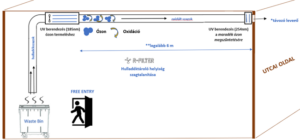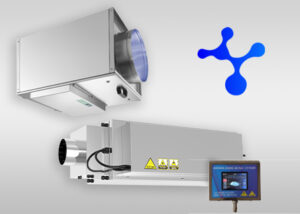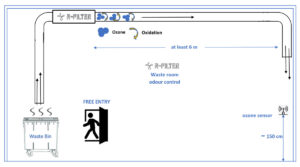
Sick Building Syndrome (SBS) is a term that refers to a set of symptoms when people living in a certain closed space experience various health symptoms due to poor air quality. These symptoms may include headaches, eye or respiratory irritation, fatigue, difficulty concentrating, and others. SBS can be associated with many factors, volatile organic compounds (VOCs) often play a role in this phenomenon.
VOCs (Volatile Organic Compounds) are organic compounds that easily escape from liquid or solid substances into the air by evaporation at room temperature. Their sources in buildings can be various materials such as paints, varnishes, adhesives, cleaning agents, furniture and other materials.
How do you prevent the Sick Building Syndrome? Measures against SBS can include: Adequate ventilation: Ensure that the building is adequately ventilated so that fresh air flows in and the concentration of indoor pollutants is reduced. Use materials with low VOC emissions: Choose building materials, furniture, paints and cleaning agents with low or no VOC emissions. Regular maintenance: regular maintenance of heating, ventilation and air conditioning systems in buildings. Evaporation period: After the installation of new materials or restoration work, a period of evaporation must be ensured, when the room is thoroughly ventilated.. Air purification: As the most effective method for removing volatile organic compounds, we recommend our UVO ozone generator with UV lamps. The most common Volatile Organic Compounds from the perspective of Sick Building Syndrome and their neutralization reactions with ozone gas: Formaldehyde: CH₂O Common sources: Plywood, fibreboard, furniture board, adhesives, thermal insulation materials and some fabrics. Reaction: CH₂O + 2O₃ → CO₂ + H₂O + 2O₂ Acetone: C₃H₆O Common sources: Nail polish remover, paint thinners and some cleaning products Reaction: C₃H₆O + 8O₃ → 3CO₂ + 3H₂O + 8O₂ Benzene: C₆H₆ Common sources: Tobacco smoke, paints, solvents and some cleaning products. Reaction: C₆H₆ + 11O₃ → 6CO₂ + 3H₂O + 11O₂ Toluene: C₇H₈ Common sources: Paints, paint thinners, adhesives and some cleaning products Reaction: C₇H₈ + 18O₃ → 7CO₂ + 4H₂O + 18O₂ Styrene: C₈ H₈ Common sources: Insulations, carpets, synthetic rubber. Reaction: C₈ H₈+ 20O₃ → 8CO₂ + 4H₂O + 20O₂ Xylene: C₈H₁₀ Common sources: Paints, varnishes, adhesives and some office equipment Reaction: C₈H₁₀ + 21O₃ → 8CO₂ + 5H₂O + 21O₂
If you are experiencing symptoms that may be related to poor indoor air quality, it is important to consult with a health professional and contact architectural experts to evaluate and address the source of potential problems. When a new building is built or renovated, higher concentrations of volatile organic compounds can be released into the indoor air.
The ozone produced by our UVO device can break down volatile organic compounds in the air and effectively neutralize unpleasant odors emitted by newly constructed or renovated buildings. Ozone also has antimicrobial properties, helping to fight bacteria, viruses and mold, thus contributing to a cleaner indoor environment. If you are considering ozone treatment to improve air quality, consider the following guidelines:
If you have specific problems, seek advice from indoor air quality specialists or environmental experts. Use our ozone generator, adapted to the size of the room and observe the safety regulations of the device. Evacuate the treated room before ozone treatment. Ensure that there is no entry into the ozone treated area during treatment. Ensure adequate ventilation before allowing people to re-enter.
Ensure that ozone concentrations remain within recommended safety limits.




